Design and Implementation of EOICHD Based Clustered Routing Protocol Variants for Wireless Sensor Networks
Abstract
1. Introduction
2. Related Literature
3. Basic Assumptions and Network Communication Model
3.1. Basic Assumptions
- The sensing nodes are distributed in random order within the sensing region.
- The nodes have fixed coordinate positions; i.e., sensing nodes and BS are stationary.
- Each node initially has two Joules of energy. Generally, energy is utilized for sensing, communicating, and data transmission. A node is said to be dead if its energy is completely depleted and is considered non-operable.
- The BS has sufficient energy so that it can never run out of energy.
- Nodes are involved in sensing, transmission, and reception of data with surrounding nodes. A node has a fixed transmission range, beyond which it cannot establish direct communication.
3.2. Network Communication Model
- is energy dissipated due to operation of hardware and selectronic components associated with a node. The typical operations on a circuit board are modulation and demodulation of signals, encoding and decoding, signal filtering, etc.
- indicate the amplifier energy.
4. Brief Overview of EOICHD Protocol
5. Variants of EOICHD Protocol
5.1. EOICHD
5.2. EOICHD
5.3. EOICHD
6. Results
- Energy consumption of the network: From this parameter, the entire network’s energy depletion can be observed.
- Number of alive nodes: The number of operational nodes, i.e., the nodes that are not dead, is measured using the parameter number of alive nodes.
- Data received by BS: The data sensed by nodes will be transmitted to BS as packets. BS keeps track of the number of data packets received by all the nodes over a period of time. A larger number of data indicates better performance of the routing protocol.
- Stability period: Based on the number of dead nodes, the stability of the network can be verified. In this context, the time instance at which the first node that becomes dead (FND), half of the nodes of the network becoming non-operational (HND), and the last node dead (LND) will help in understanding network lifetime.
- Scenario #1: Given the simulation area m, the position of the base station is located at (50, 50) of simulation area (the base station is at the center of simulation area).
- Scenario #2: Given the simulation area m, the position of the base station is located at (50, 175) of simulation area (the base station is located out of the simulation area).
6.1. Number of Alive Nodes
6.2. Average Energy Consumption
6.3. Average Data Packets Received by BS
6.4. Stability Period
7. Conclusions
Author Contributions
Funding
Institutional Review Board Statement
Informed Consent Statement
Data Availability Statement
Conflicts of Interest
References
- Liu, X. Atypical Hierarchical Routing Protocols for Wireless Sensor Networks: A Review. IEEE Sens. J. 2015, 15, 5372–5383. [Google Scholar] [CrossRef]
- Akyildiz, I.; Su, W.; Sankarasubramaniam, Y.; Cayirci, E. Wireless sensor networks: A survey. Comput. Netw. 2002, 38, 393–422. [Google Scholar] [CrossRef]
- Abbasi, A.A.; Younis, M. A survey on clustering algorithms for wireless sensor networks. Comput. Commun. 2007, 30, 2826–2841. [Google Scholar] [CrossRef]
- Sunny, A.I.; Zhao, A.; Li, L.; Kanteh Sakiliba, S. Low-Cost IoT-Based Sensor System: A Case Study on Harsh Environmental Monitoring. Sensors 2021, 21, 214. [Google Scholar] [CrossRef]
- Rashvand, H.F.; Abedi, A. Wireless sensor systems for extreme environments. In Wireless Sensor Systems for Extreme Environments: Space, Underwater, Underground, and Industrial; John Wiley & Sons Ltd.: Hoboken, NJ, USA, 2017; p. 5. [Google Scholar]
- Gupta, V.; Pandey, R. An improved energy aware distributed unequal clustering protocol for heterogeneous wireless sensor networks. Eng. Sci. Technol. Int. J. 2016, 19, 1050–1058. [Google Scholar] [CrossRef]
- Mo, Y.; Wang, B.; Liu, W.; Yang, L.T. A Sink-Oriented Layered Clustering Protocol for Wireless Sensor Networks. Mob. Netw. Appl. 2013, 18, 639–650. [Google Scholar] [CrossRef]
- Ehsan, S.; Hamdaoui, B. A Survey on Energy-Efficient Routing Techniques with QoS Assurances for Wireless Multimedia Sensor Networks. IEEE Commun. Surv. Tutor. 2012, 14, 265–278. [Google Scholar] [CrossRef]
- Chatei, Y.; Ghoumid, K.; Hammouti, M.; Hajji, B. Efficient coding techniques algorithm for cluster-heads communication in wireless sensor networks. AEU-Int. J. Electron. Commun. 2017, 82, 294–304. [Google Scholar]
- Moh’d Alia, O. Dynamic relocation of mobile base station in wireless sensor networks using a cluster-based harmony search algorithm. Inf. Sci. 2017, 385, 76–95. [Google Scholar] [CrossRef]
- Muthukumaran, K.; Chitra, K.; Selvakumar, C. An energy efficient clustering scheme using multilevel routing for wireless sensor network. Comput. Electr. Eng. 2018, 69, 642–652. [Google Scholar]
- Sirdeshpande, N.; Udupi, V. Fractional lion optimization for cluster head-based routing protocol in wireless sensor network. J. Frankl. Inst. 2017, 354, 4457–4480. [Google Scholar] [CrossRef]
- Akkaya, K.; Younis, M. A survey on routing protocols for wireless sensor networks. Ad. Hoc Netw. 2005, 3, 325–349. [Google Scholar] [CrossRef]
- Arjunan, S.; Pothula, S. A survey on unequal clustering protocols in wireless sensor networks. J. King Saud-Univ.-Comput. Inf. Sci. 2019, 31, 304–317. [Google Scholar] [CrossRef]
- Shahraki, A.; Rafsanjani, M.K.; Saeid, A.B. A new approach for energy and delay trade-off intra-clustering routing in WSNs. Comput. Math. Appl. 2011, 62, 1670–1676. [Google Scholar] [CrossRef]
- Heinzelman, W.; Chandrakasan, A.; Balakrishnan, H. Energy-Efficient Communication Protocols for Wireless Microsensor Networks. In Proceedings of the 33rd Annual Hawaii International Conference on System Sciences, Maui, HI, USA, 7 January 2000. [Google Scholar]
- Heinzelman, W.B.; Chandrakasan, A.P.; Balakrishnan, H. An application-specific protocol architecture for wireless microsensor networks. IEEE Trans. Wirel. Commun. 2002, 1, 660–670. [Google Scholar] [CrossRef]
- Sibahee, M.A.A.; Lu, S.; Masoud, M.Z.; Hussien, Z.A.; Hussain, M.A.; Abduljabbar, Z.A. LEACH-T: LEACH Clustering Protocol Based on Three Layers. In Proceedings of the 2016 International Conference on Network and Information Systems for Computers (ICNISC), Wuhan, China, 15–17 April 2016; pp. 36–40. [Google Scholar]
- Bongale, A.M.; Swarup, A.; Shivam, S. EiP-LEACH: Energy influenced probability based LEACH protocol for Wireless Sensor Network. In Proceedings of the 2017 International Conference on Emerging Trends Innovation in ICT (ICEI), Pune, India, 3–5 February 2017; pp. 77–81. [Google Scholar]
- Singh, S.K.; Kumar, P.; Singh, J.P. A Survey on Successors of LEACH Protocol. IEEE Access 2017, 5, 4298–4328. [Google Scholar] [CrossRef]
- Lin, H.; Wang, L.; Kong, R. Energy Efficient Clustering Protocol for Large-Scale Sensor Networks. IEEE Sens. J. 2015, 15, 7150–7160. [Google Scholar] [CrossRef]
- Dong, Y.; Wang, J.; Shim, B.; Kim, D.I. DEARER: A Distance-and-Energy-Aware Routing With Energy Reservation for Energy Harvesting Wireless Sensor Networks. IEEE J. Sel. Areas Commun. 2016, 34, 3798–3813. [Google Scholar] [CrossRef]
- Ke, W.; Yangrui, O.; Hong, J.; Heli, Z.; Xi, L. Energy aware hierarchical cluster-based routing protocol for WSNs. J. China Univ. Posts Telecommun. 2016, 23, 46–52. [Google Scholar] [CrossRef]
- Rani, S.; Ahmed, S.H.; Malhotra, J.; Talwar, R. Energy efficient chain based routing protocol for underwater wireless sensor networks. J. Netw. Comput. Appl. 2017, 92, 42–50. [Google Scholar] [CrossRef]
- Nayak, P.; Devulapalli, A. A Fuzzy Logic-Based Clustering Algorithm for WSN to Extend the Network Lifetime. IEEE Sens. J. 2016, 16, 137–144. [Google Scholar] [CrossRef]
- Abidi, W.; Ezzedine, T. Fuzzy Cluster Head Election algorithm based on LEACH protocol for wireless sensor networks. In Proceedings of the 2017 13th International Wireless Communications and Mobile Computing Conference (IWCMC), Valencia, Spain, 26–30 June 2017; pp. 993–997. [Google Scholar]
- Bongale, A.M.; Nirmala, C.R. EOICHD: A Routing Scheme for Wireless Sensor Network Based on Energy and Optimal Inter Cluster Head Distance. Int. J. Appl. Eng. Res. 2016, 11, 7256–7266. [Google Scholar]
- Kavitha, A.; Guravaiah, K.; Velusamy, R.L. A cluster-based routing strategy using gravitational search algorithm for wsn. J. Comput. Sci. Eng. 2020, 14, 26–39. [Google Scholar] [CrossRef]
- Teerawat, I.; Hossain, E. Introduction to Network Simulator NS2; Springer: Boston, MA, USA, 2009; pp. 1–18. [Google Scholar]
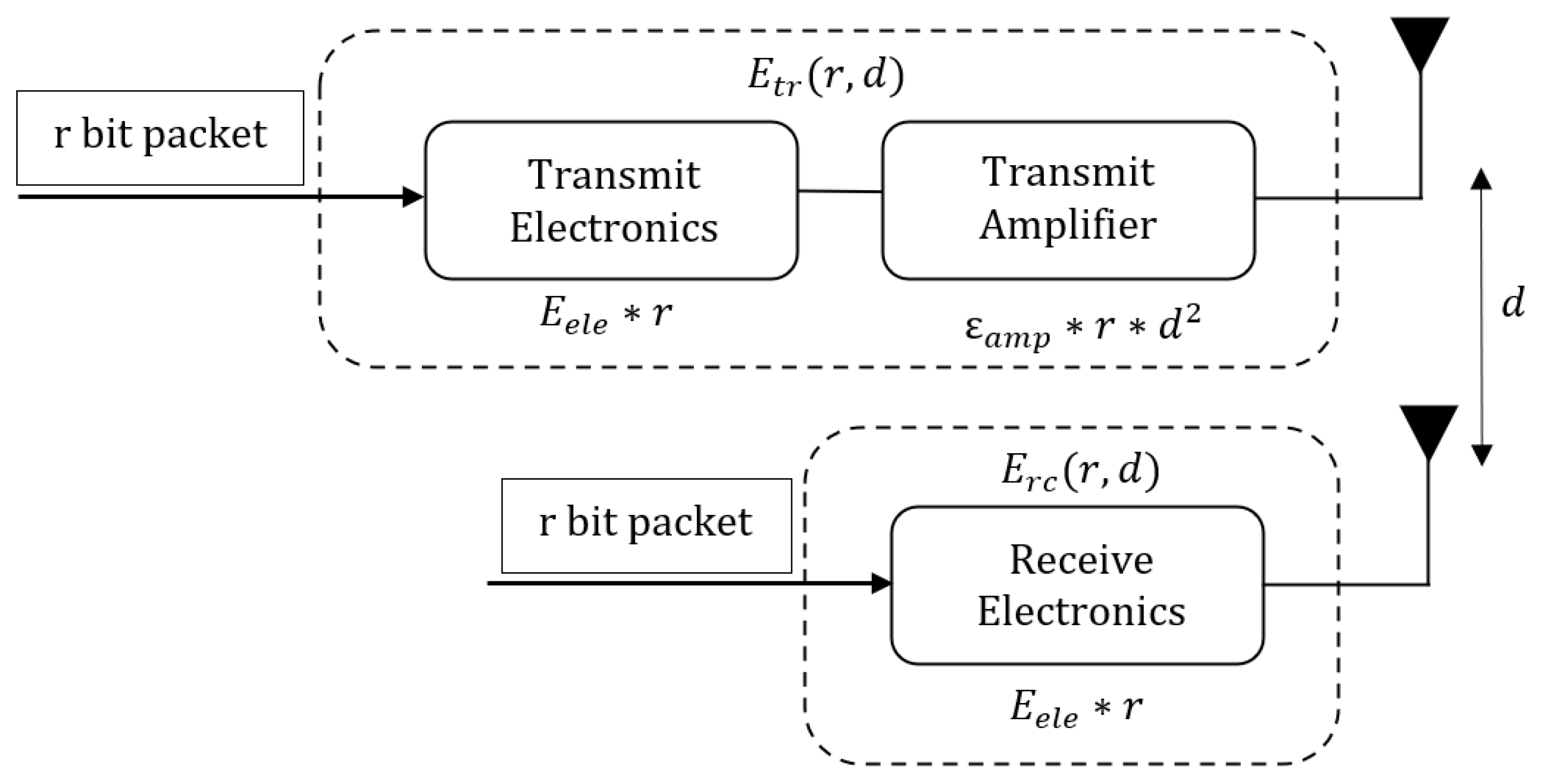
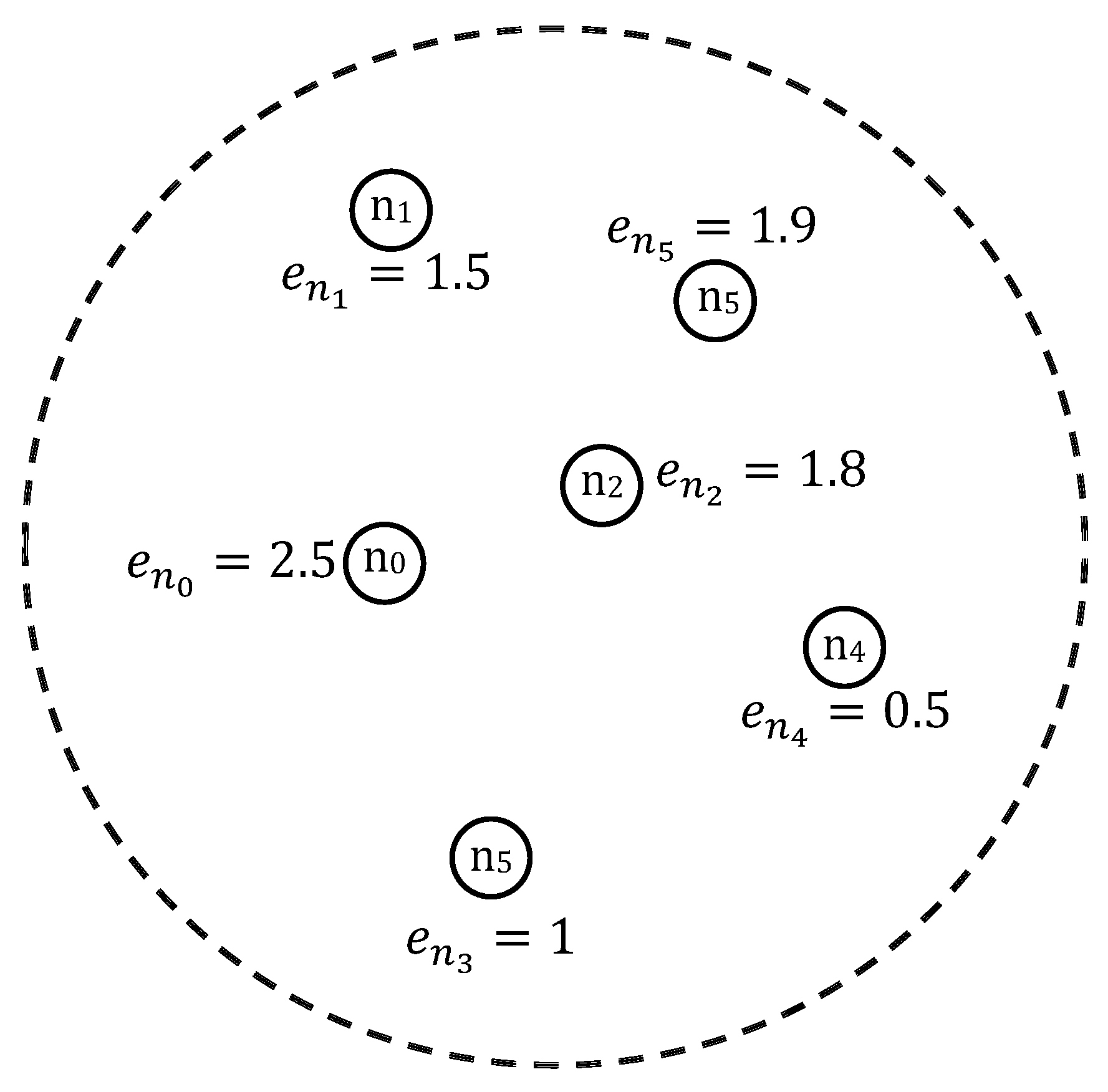

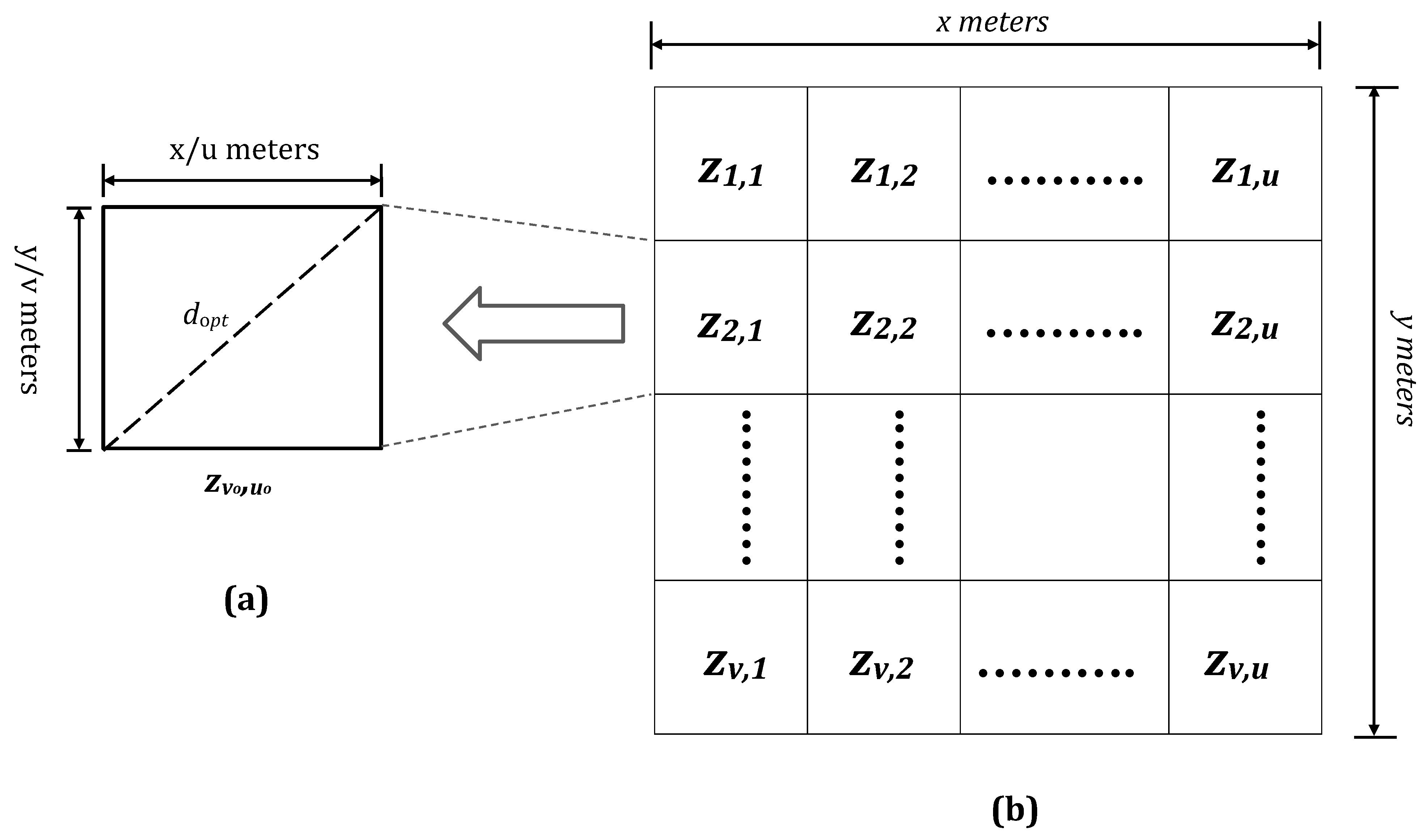
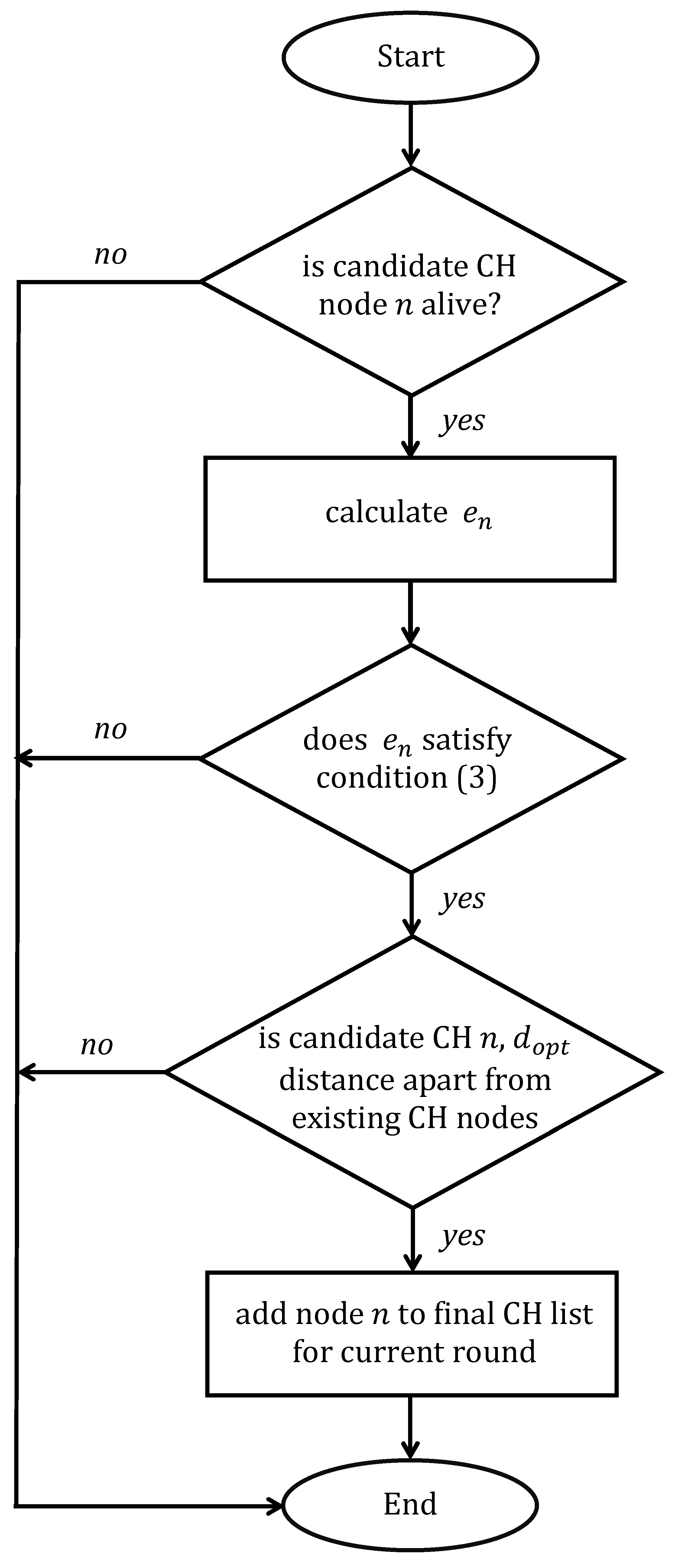
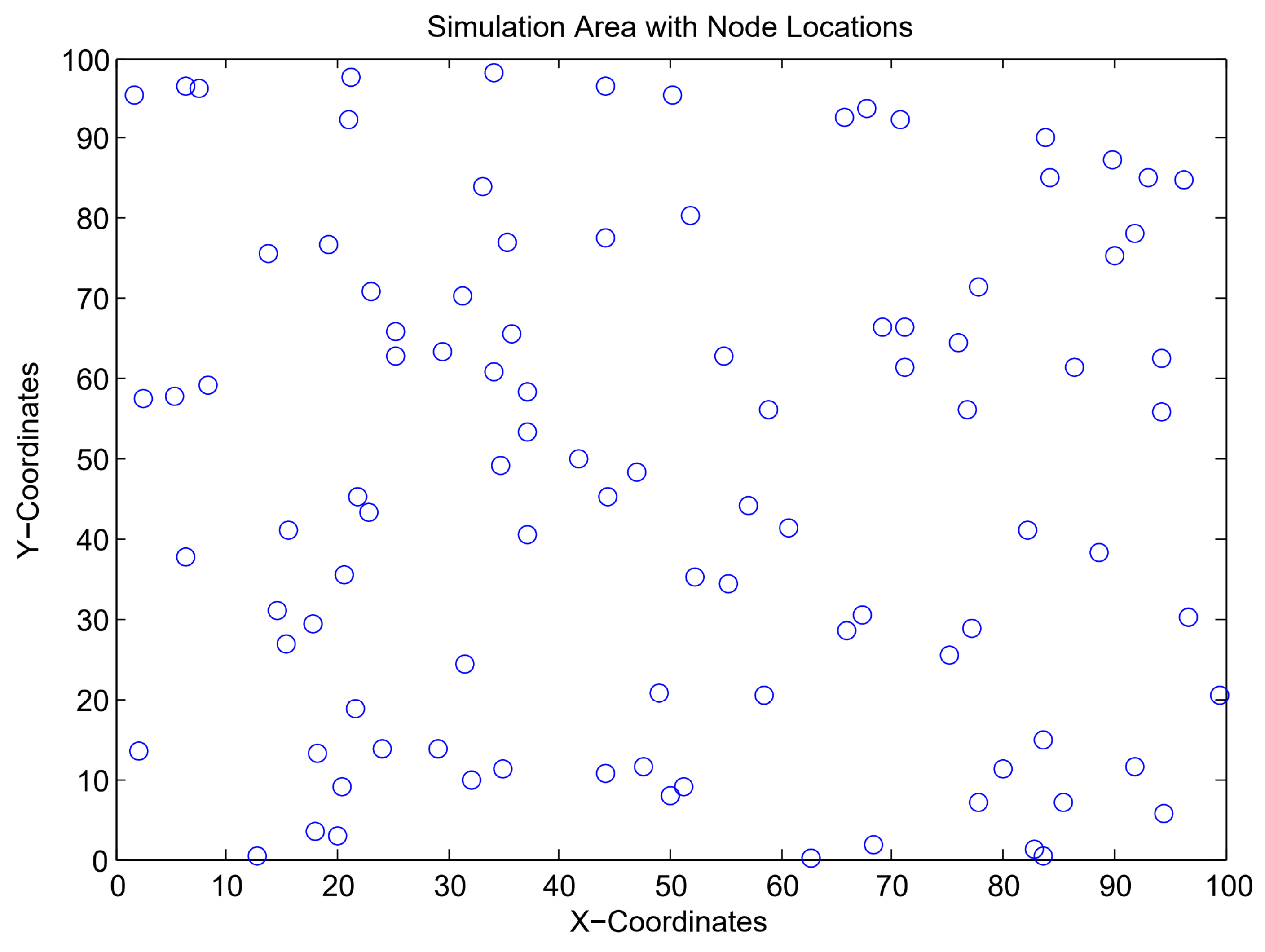
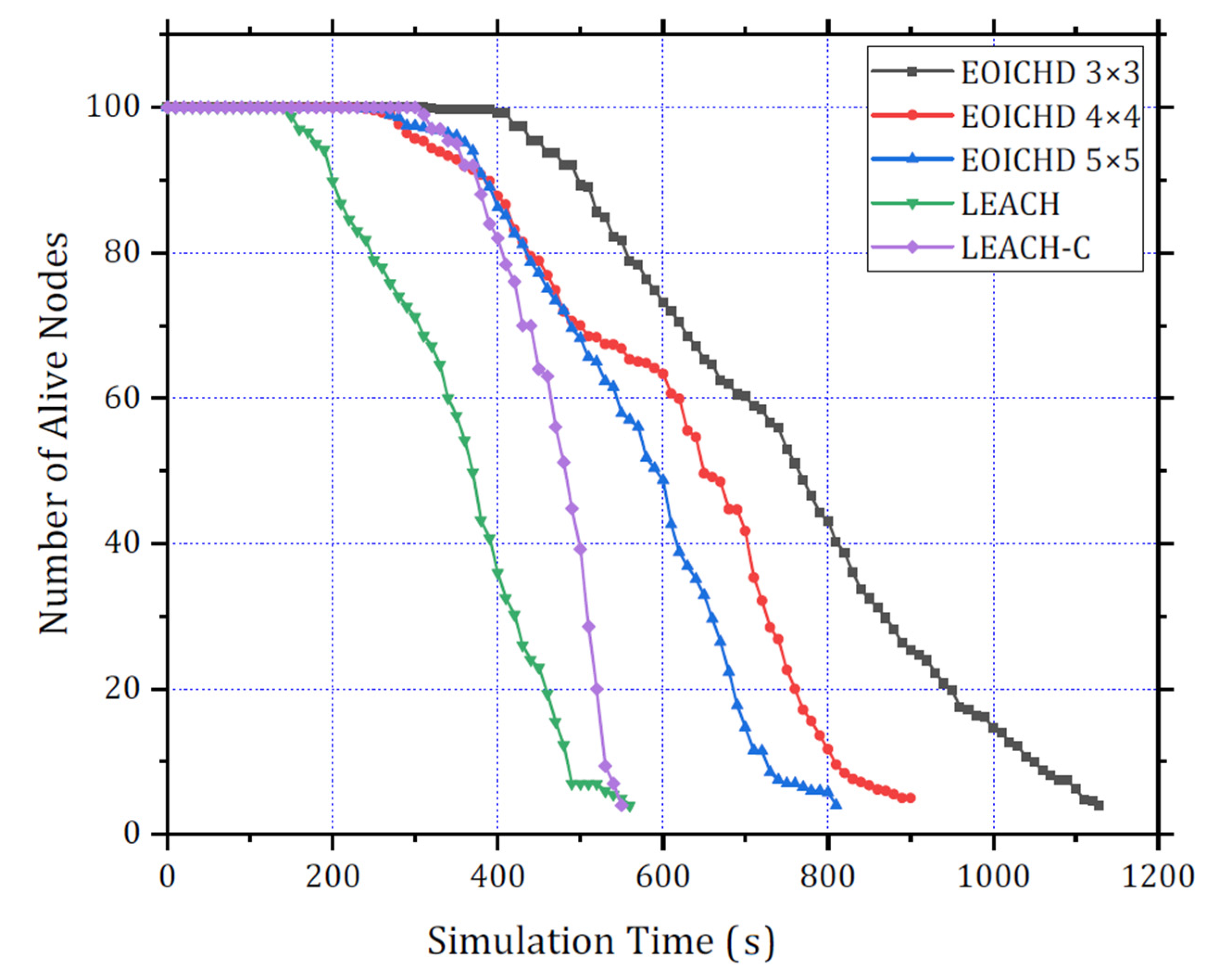
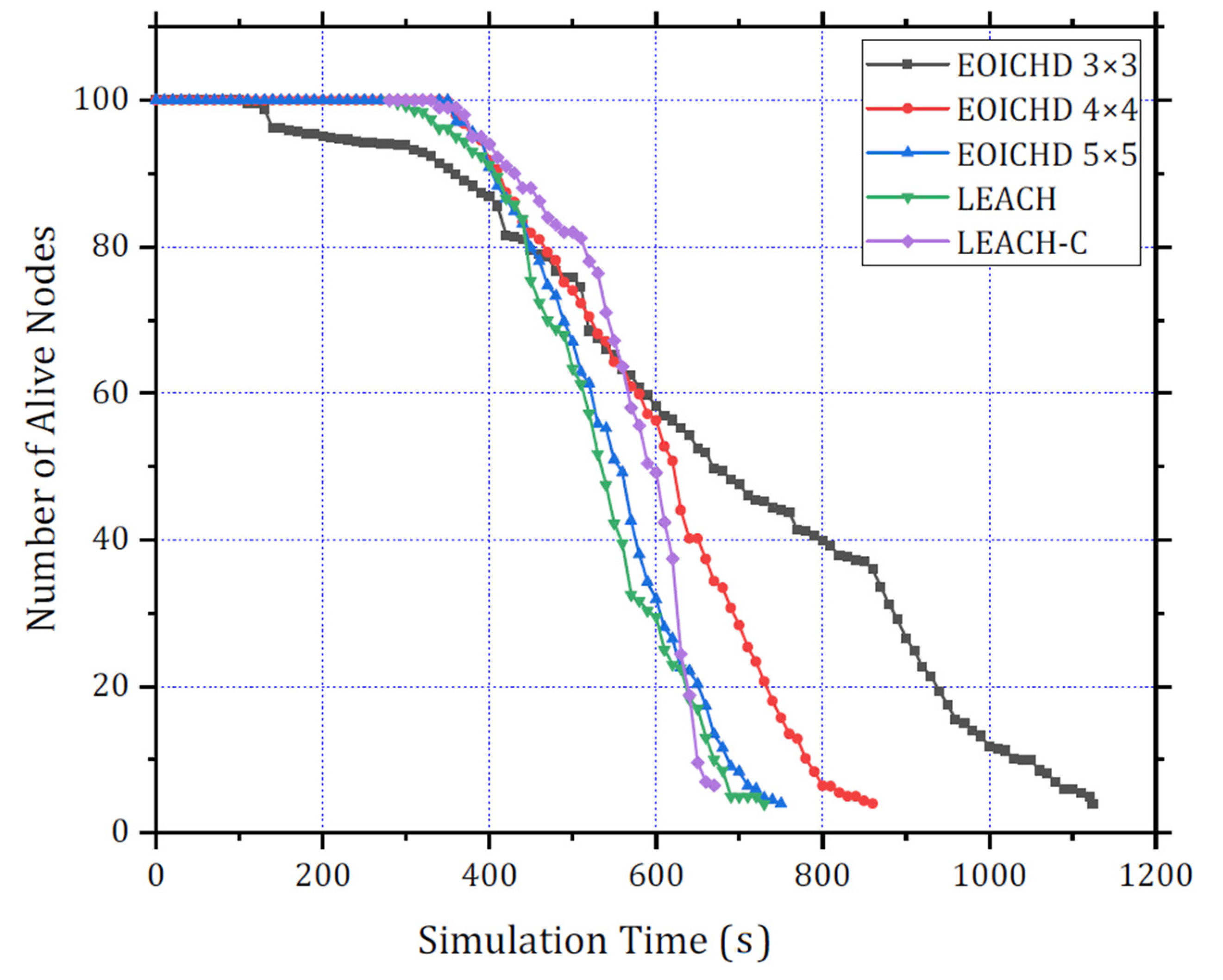
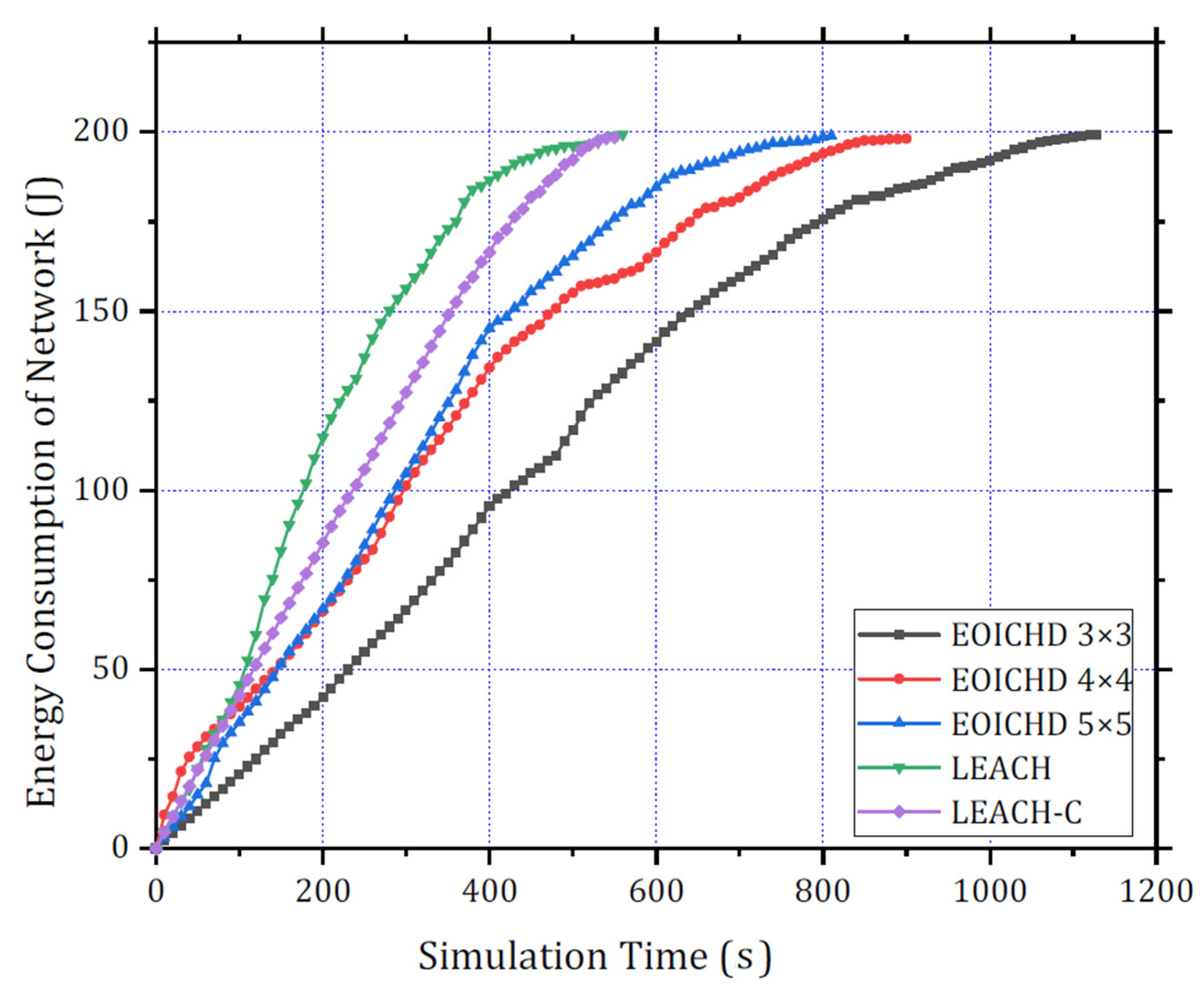
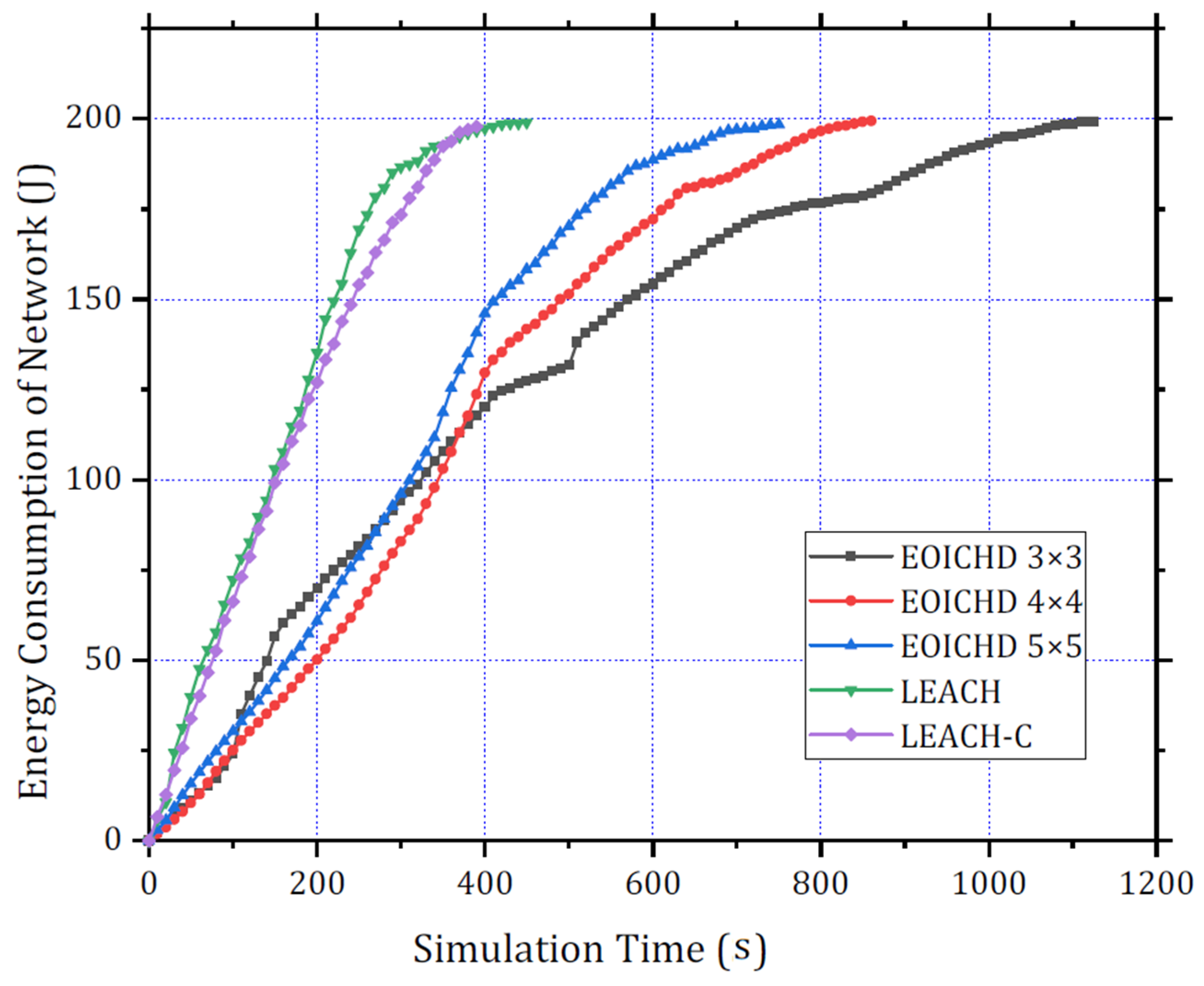
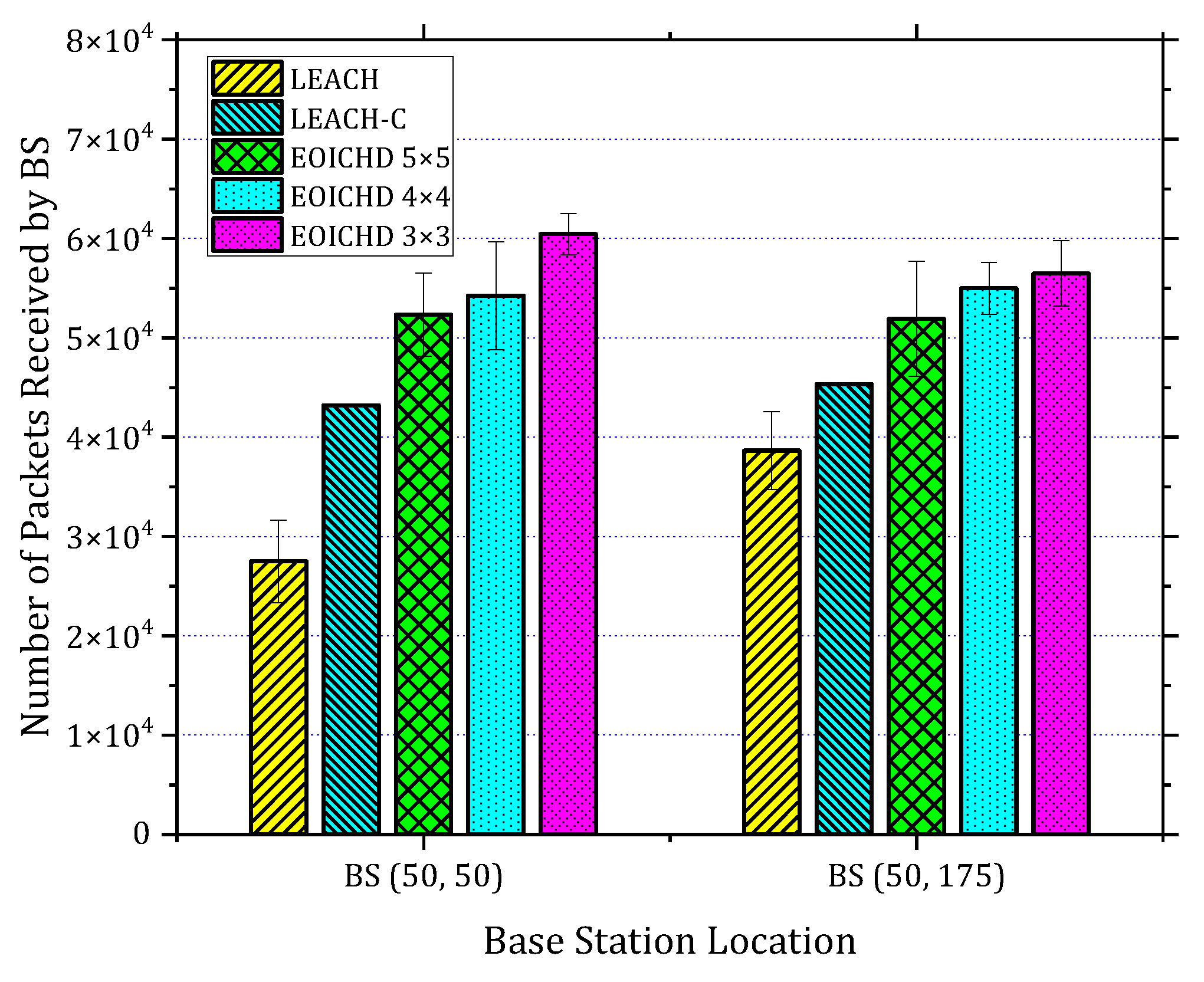
| Node ID | Case 1 | Case 2 | ||
|---|---|---|---|---|
| Remaining Energy of Node | Remarks | Remaining Energy of Node | Remarks | |
| 2.5 | Candidate CH | 4 | Candidate CH | |
| 1.5 | – | 1.5 | – | |
| 1.8 | Candidate CH | 1.6 | – | |
| 1 | – | 1 | – | |
| 0.5 | – | 0.5 | – | |
| 1.9 | Candidate CH | 1.9 | Candidate CH | |
| – | 1.53 | Average energy | 1.75 | Average energy |
| Criteria | Values |
|---|---|
| Number of nodes | 100 |
| Size of the simulation area | m |
| Starting Energy of Node | 2 J |
| Total Initial Energy of Network | J |
| Scenario#1 | Base station is located at |
| Scenario#2 | Base station is located at |
| nJ/bit | |
| pJ/bit/m | |
| pJ/bit/m |
| Routing Protocols | FND | HND | LND |
|---|---|---|---|
| 321.3 | 774 | 1128 | |
| 240.2 | 654.2 | 903 | |
| 172 | 602 | 813 | |
| LEACH | 153 | 371.2 | 564 |
| LEACH-C | 311 | 493.2 | 552.4 |
| Routing Protocols | FND | HND | LND |
|---|---|---|---|
| 112 | 672 | 1124.3 | |
| 353.4 | 620 | 863 | |
| 355 | 551.7 | 754 | |
| LEACH | 293 | 543 | 734.3 |
| LEACH-C | 344 | 603.4 | 671 |
Publisher’s Note: MDPI stays neutral with regard to jurisdictional claims in published maps and institutional affiliations. |
© 2021 by the authors. Licensee MDPI, Basel, Switzerland. This article is an open access article distributed under the terms and conditions of the Creative Commons Attribution (CC BY) license (https://creativecommons.org/licenses/by/4.0/).
Share and Cite
Bongale, A.; Bongale, A.; Kumar, S.; Joshi, R.; Bhamidipati, K. Design and Implementation of EOICHD Based Clustered Routing Protocol Variants for Wireless Sensor Networks. Appl. Syst. Innov. 2021, 4, 25. https://doi.org/10.3390/asi4020025
Bongale A, Bongale A, Kumar S, Joshi R, Bhamidipati K. Design and Implementation of EOICHD Based Clustered Routing Protocol Variants for Wireless Sensor Networks. Applied System Innovation. 2021; 4(2):25. https://doi.org/10.3390/asi4020025
Chicago/Turabian StyleBongale, Anupkumar, Arunkumar Bongale, Satish Kumar, Rahul Joshi, and Kishore Bhamidipati. 2021. "Design and Implementation of EOICHD Based Clustered Routing Protocol Variants for Wireless Sensor Networks" Applied System Innovation 4, no. 2: 25. https://doi.org/10.3390/asi4020025
APA StyleBongale, A., Bongale, A., Kumar, S., Joshi, R., & Bhamidipati, K. (2021). Design and Implementation of EOICHD Based Clustered Routing Protocol Variants for Wireless Sensor Networks. Applied System Innovation, 4(2), 25. https://doi.org/10.3390/asi4020025








